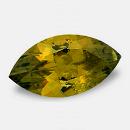|
|
|
|
Click on a letter above to view the list of gems. |
|
|
|
|
|
Epidote |
|
| Chemistry: Ca2(Al,Fe)3Si3O12(OH) | |
| Discovered
in 1801;
IMA
status: Valid (pre-IMA; Grandfathered). | ||
|
| ||
|
Classification |
|
|
| |
|
Silicates | |
|
8/C.23-20 | |
|
|
9 : SILICATES (Germanates) |
|
|
|
|
|
|
|
Crystal Data |
|
|
|
|
|
Crystals prismatic to 35cm. Fibrous, coarse to fine granular, massive |
|
|
On [100], contact, lamellar, common |
|
|
|
|
|
Physical Properties |
|
|
|
|
|
[001] Perfect, [100] Imperfect |
|
|
Irregular/Uneven |
|
|
Brittle |
|
|
6.0 - 7.0 |
|
|
3.38 - 3.49 (g/cm3) |
|
|
None |
|
|
Not Radioactive |
|
|
|
|
|
Optical Properties |
|
|
|
|
|
Pistachio-Green to pale Green, Yellow, Yellowish Green, Greenish Yellow, Greenish Black; |
|
|
Transparent, Opaque |
|
|
Vitreous, Pearly |
|
|
1.715 - 1.797 Biaxial ( - ) |
|
|
0.019 - 0.046 |
|
|
0.019; Strong; r > v |
|
|
Strong; X = colorless, pale yellow, pale green; Y = greenish yellow; Z = yellowish green |
|
|
|
|
|
Occurances |
|
|
|
|
|
Geological Setting: |
Regional and contact metamorphic rocks. Saussuritization (alteration of plagioclase). |
|
Type Locality: |
Bourg d'Oisans, Isère, Rhône-Alpes, France |
|
Year Discovered: |
1801 |
|
View mineral photos: | |
|
|
|
|
More Information |
|
|
|
|
|
| |
|
|
|
|
There
are many locations worldwide were Epidote is found but
few produce gem quality crystals. A few gem locations
are Corinthia and Salzburg, Austria; Minas Gerais, Brazil;
Provence-Alpes-Côte d'Azur
& Bourg d'Oisans, Isère, Rhône-Alpes, France; Aosta
Valley, Italy; Baltistan & Tormiq, Pakistan; Ticino,
Switzerland; Chaffee County, Colorado, USA and Lamoille
& Orleans Counties, Vermont, USA. |
|
|
We
have not photographed our Epidote gems yet. Please
check back soon! |
